In 2005, the Burning Man was built and then set ablaze for the 20th time. No one could have predicted, back on Baker Beach in 1986, that a match was being put not just to an effigy, but also to the start of a cultural revolution. In the intervening decades, Burning Man has grown and matured, and in some ways, it has come into its prime. Like a child reaching adulthood, Burning Man has turned to face the world.
A common sentiment wends its way through this Afterburn Report: Burning Man had, very simply, a great year in 2005 … not only for the event, but for the organization, and the larger participant community, as well.
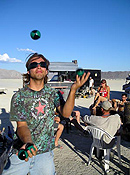 Staffers labored through the off-season to improve the operational efficiency of the organization. All departments, from Media Mecca to the Department of Public Works, from Community Services to Technology, made great strides and realized sweeping successes in 2005. You’ll see these advances laid out in detail throughout this report. Simply put, infrastructural and organizational processes have become dialed in, allowing the focus to shift toward the future.
Staffers labored through the off-season to improve the operational efficiency of the organization. All departments, from Media Mecca to the Department of Public Works, from Community Services to Technology, made great strides and realized sweeping successes in 2005. You’ll see these advances laid out in detail throughout this report. Simply put, infrastructural and organizational processes have become dialed in, allowing the focus to shift toward the future.
While everyone worked, all watched with bemused satisfaction as the event, community, and culture hit a pinnacle of media attention in the event’s 20th year of existence. This story – the real story of who we are and why we do what we do – was shared in rich detail with a global audience. The event itself seemed to rise to the occasion of its moment in the fickle media spotlight, reflecting back the glow, but not before magnifying it multifold with an influx of the infectious creative energy borne of unmediated experience.
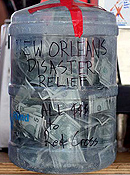 In 2005, the Burning Man community reached out to the world beyond the event. As news of Hurricane Katrina’s destructive wrath trickled into Black Rock City, participants quickly organized and took action, raising over $35,000 in donations for the relief effort while still at the event, and deploying crews to the area that eventually helped reconstruct a devastated Biloxi community. There they applied methods learned in the desert – building domes, gifting supplies, fostering community, and working in the face of brutal adversity – to get the job done. Dedicated crews adopted the moniker “Burners Without Borders,” which truly speaks to the future of Burning Man, taking the event’s principles off the playa and out into the world. Learn more at www.burnerswithoutborders.org.
In 2005, the Burning Man community reached out to the world beyond the event. As news of Hurricane Katrina’s destructive wrath trickled into Black Rock City, participants quickly organized and took action, raising over $35,000 in donations for the relief effort while still at the event, and deploying crews to the area that eventually helped reconstruct a devastated Biloxi community. There they applied methods learned in the desert – building domes, gifting supplies, fostering community, and working in the face of brutal adversity – to get the job done. Dedicated crews adopted the moniker “Burners Without Borders,” which truly speaks to the future of Burning Man, taking the event’s principles off the playa and out into the world. Learn more at www.burnerswithoutborders.org.
Burning Man stands on the very precipice of the future. If only by virtue of the fact that this year’s successes were born from the ashes of the challenging year of 2004, the future looks bright, and global.
Some found it fair to say, “Burning Man 2005 was the best event ever. Certainly 35,600 unique experiences took place on the playa, but they shared a palpable undercurrent. We saw it, felt it, and more importantly, we were it. The vibrant power of expressed individuality shed its self-centered limitations, and rose up into the collectivity of a community experience. Many a participant has reported a tangible connection between everybody on the playa – a discernable vibe, and an almost complete dissolution of the line between participant and event, coupled with a quiet blurring of the lines between the community’s myriad subcultures.
Overall, the city’s infrastructure ran as smoothly as possible. From the Gate to the Greeters, from Emergency Services to Exodus, all the departments in the Burning Man organization seemed to have their processes on rails, and experience showed in the execution. As a result, staffers and volunteers enjoyed their playa time more, and this vibe permeated through the city’s population. (It probably didn’t hurt that more porta-potties were placed throughout the city in 2005.)
Mother Nature played nice and blessed the BRC encampment with some of the best weather the event has seen. After some short-lived wind storms on Monday, the remainder of the week saw light winds, reasonable daytime and nighttime temperatures, beautiful blue skies, and a solid playa surface. Gone were the viciously chilly dust storms of 2004, so artists completed their projects without being battered senseless, and everybody could explore their city with ease.
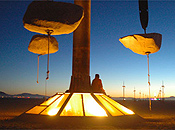 And when they did, they found some incredible art. The event benefited from an increase in the Burning Man Project’s art grants from $250,000 to $425,000, with funding for 52 art installations, helping to bring more art to the playa than ever before – 275 installations in total. Magnificent pieces broke through thresholds of experience, engineering, design, and interactivity, opening the door to riches of inspired possibilities in future years. From Colossus to The Dicky Box, The Machine, and The Dreamer, from the Angel of the Apocalypse to the Mousetrap, the art of 2005 was, in a word, outstanding.
And when they did, they found some incredible art. The event benefited from an increase in the Burning Man Project’s art grants from $250,000 to $425,000, with funding for 52 art installations, helping to bring more art to the playa than ever before – 275 installations in total. Magnificent pieces broke through thresholds of experience, engineering, design, and interactivity, opening the door to riches of inspired possibilities in future years. From Colossus to The Dicky Box, The Machine, and The Dreamer, from the Angel of the Apocalypse to the Mousetrap, the art of 2005 was, in a word, outstanding.
And the mainstream art press paid attention. Burning Man and its artists piqued attention – and garnered respect – from publications such as Art in America, finally giving the event’s talented artists the recognition they deserve for creating groundbreaking work.
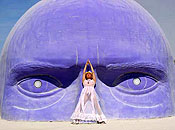 In order to raise the stage for fire art in particular, The Fire Circle was created halfway between the Man and the end of the 12:00 promenade. Anchored at its center by Pepe Ozan’s Dreamer embedded in the playa floor, it featured a broad circle of six major fire-art installations, creating a glowing focus each night of the event. While it had the unfortunate side effect of obscuring smaller fire pieces, it definitely brought fire art back to the forefront of Burning Man’s nights.
In order to raise the stage for fire art in particular, The Fire Circle was created halfway between the Man and the end of the 12:00 promenade. Anchored at its center by Pepe Ozan’s Dreamer embedded in the playa floor, it featured a broad circle of six major fire-art installations, creating a glowing focus each night of the event. While it had the unfortunate side effect of obscuring smaller fire pieces, it definitely brought fire art back to the forefront of Burning Man’s nights.
The event’s relationship to art was influenced by a group of concerned artists who organized to form “BORG2” immediately following the 2004 event. They mounted a boisterous campaign of protest against what they perceived to be insular and self-limiting policies and practices of the Burning Man Art Department, particularly with regard to the process by which artists are selected to receive funding grants.
While many BORG2 complaints were rooted in rumor rather than fact, the essence of their grievance had validity, and it was taken into account as the Art Department reinvented itself. At the very least, the protest shook up preconceived notions about the relationship of artists to the Burning Man community and triggered rethinking of the approach to that relationship.
This relationship has also been manifested in the ongoing development of Burning Man’s sister organization, the Black Rock Arts Foundation whose mission is to fund interactive, community-based artwork off the playa yearround. Quality partnerships within the San Francisco government has resulted in several pieces of Burning Man art being placed around the city, with still more to come.
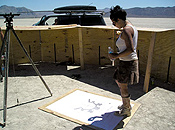 Addressing another challenge in 2005, Black Rock City’s planning team responded to the pervasive feeling that civic environment was becoming bifurcated between city and suburbs. The Esplanade has felt like a boardwalk experience. The planners took on an initiative to redesign Black Rock City’s layout, extending a portion of the 485 theme camps out into the “suburbs” in hopes of creating organic micro-communities or neighborhoods. Generally, this change was met with a favorable response from participants. In 2005, the Esplanade felt like less of a spectator walkway and more of an interactive promenade, while the suburbs enjoyed an influx of energy.
Addressing another challenge in 2005, Black Rock City’s planning team responded to the pervasive feeling that civic environment was becoming bifurcated between city and suburbs. The Esplanade has felt like a boardwalk experience. The planners took on an initiative to redesign Black Rock City’s layout, extending a portion of the 485 theme camps out into the “suburbs” in hopes of creating organic micro-communities or neighborhoods. Generally, this change was met with a favorable response from participants. In 2005, the Esplanade felt like less of a spectator walkway and more of an interactive promenade, while the suburbs enjoyed an influx of energy.
Adding to that emotional energy on the playa, participants gained direct access to the Man for the first time since 2000, giving them a sense of personal connection with everyone’s favorite stick figure and helping to reaffirm their place in the community. Participants were offered the opportunity to rotate the Man on an ingeniously designed pivoting axis, disorienting the psyches of participants, who would otherwise rely on the Man’s orientation as a navigational aid.
 To reach the Man, participants puzzled through an elaborate maze filled with over 40 interactive art installations. Built to draw together participants in a communal and interactive art experience, the Funhouse proved to be an extremely popular place to play, and its success has certainly set the stage for future interactive Man platforms.
To reach the Man, participants puzzled through an elaborate maze filled with over 40 interactive art installations. Built to draw together participants in a communal and interactive art experience, the Funhouse proved to be an extremely popular place to play, and its success has certainly set the stage for future interactive Man platforms.
Total population showed flat growth from 2004 (likely due to the aforementioned weather and art issues), but 2005 saw a marked increase in the number of virgin participants, who were well-educated about the Burning Man ethos and principles. All in all, the “yahoo” factor was in limited effect, illustrated by nearly non-existent problems with vandalism, matter out of place (MOOP), and porta-potty abuse. In the end, the final sweeps of the city by hard-working clean-up crews went smoother than ever.
More than just an annual event, Burning Man is a way of life that inspires people to reconsider their relationship to the outside world. The Regional Network, the physical manifestation of that idea, grew to 80 strong in 2005. The Regional Information Center (RIC) in Center Camp provided a place for participants to learn about what happens off-playa year-round, get website information about the regional groups nearest them, and join regional announce lists.
Now, 20 years into the evolution of the Burning Man community, each of those years has been rife with challenge and response, struggle and accomplishment. Each saw the steady growth of Black Rock City’s population, and the movement it represents. Each of those years has offered a piece of the assembling puzzle, a step in the development, and lessons learned. Each of those years was anchored in the core Ten Principles, providing the guidelines by which we Burn. The community has reached a seminal point in its evolution, one that sees us standing on a platform, ready to launch headlong – and consciously – into our collective future.
So was 2005 the best year ever? No, it wasn’t. It was the best year yet.
Submitted by,
Will Chase

